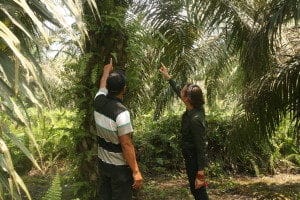On the Ground in Sumatra: Working Toward Sustainable Palm Oil
Left: Kate Kroll, Green Century Shareholder Advocate, with a farmer on a sustainable palm plantation.
As I mentioned in my previous post from Jakarta, palm oil is the most widely used vegetable oil in the world and can be found in many common household products, from shampoo to crackers and other snack foods. Its unsustainable cultivation and production is leading to a number of environmental and societal issues in Southeast Asia and parts of South America including, but not limited to, rainforest and endangered species’ habitat destruction, human and labor rights violations, and climate change. In fact, forest destruction contributes nearly the same amount of global greenhouse gas emissions as the entire transportation sector.
This is not to say that we, as consumers, should or must stop consuming products containing palm oil. It’s quite the opposite, actually. Companies are responding to increased concern from investors, not only about the environmental and social issues posed by unsustainable, or conflict, palm oil, but also about the tangible business risks they see in unsustainable operations, which could include legal liabilities in emerging markets, pending legislation, reputational risk, and the ability to access raw materials to maintain revenue streams. As pressure from investors to change their supply chains and integrate sustainable sourcing practices for palm oil and other commodities grows, companies are making the commitments needed to protect forests, and it is up to us as investors and consumers to demonstrate the market uptake of the sustainably sourced commodities.
And we are beginning to see tangible change. During the last few days, my peers and I have met with smallholders, which are primary producers of palm on small parcels of land, and were even able to tour a sustainable plantation, newly-certified by the Roundtable on Sustainable Palm Oil (RSPO) in the Pelawlwan district of Raiu with the Amanah smallholders association.
During this visit, we saw where fresh fruit bunches (FFB) are sourced, which is the very beginning of the palm oil supply chain. The farmers we met with spoke about how having the certification from RSPO has created a reliable economy. Before the certification, they were exposed to a more volatile market because they claimed that companies would not buy from them when they employed slash and burn techniques due to pressure from end users, such as Kellogg’s,* to supply non-conflict palm.
According to the people I’ve met with, not only are non-conflict palm practices improving the standard of living for indigenous peoples, they are also improving the habitats for many exotic and endangered species of Southeast Asia. I had the opportunity to meet with Dr. Winsu Sukmantoro, Central Sumatra Leader of World Wildlife Fund-Indonesia, who noted that deforestation has drastically endangered animals like elephants in the region. But, largely due to the political and private commitment to no deforestation, peat, and exploitation (DPE), the population has stabilized.
I, and my colleagues, do this work to improve the state of our planet and the many people who inhabit it. It’s experiences like those I’ve had over the past several days that truly show how our work is making an impact. We know there is plenty of work left to be done, however. While I’ve seen firsthand the benefits our work has accomplished, many I’ve spoken with mentioned how long and difficult the sustainable palm certification process is. As we move forward, buy-in from smallholders will be crucial, especially given that they account for four million tons of palm oil, or close to nine percent of total global production.
But it is starting to become clear how the sustainable sourcing of palm oil is not only feasible, but also quite possibly the solution to many of the environmental and social issues taking place in this part of the world. What I’ve seen so far on this trip leads me to believe that both large and small producers will see the benefits of non-conflict palm and that we will soon be on a path toward an even more sustainable economy and planet that provides opportunity for all.
The Green Century Equity Fund
Kate Kroll, Green Century’s shareholder advocate working on forest protection, is in Southeast Asia this month reporting on the results of Green Century’s forest protection work in transforming the palm oil supply chain. Sign up here to get updates sent right to your inbox.
*As of June 30, 2016, Kellogg company comprised 0.00% and 0.28% of the Green Century Balanced Fund and the Green Century Equity Fund, respectively. References to specific securities, which will change due to the ongoing management of the Funds, should not be construed as a recommendation by the Funds, their administrator, or their distributor.
Stocks will fluctuate in response to factors that may affect a single company, industry, sector, or the market as a whole and may perform worse than the market. Bonds are subject to a variety of risks including interest rate, credit, and inflation risk. The Funds’ environmental criteria limit the investments available to the Funds compared to mutual funds that do not use environmental criteria.
This information has been prepared from sources believed to be reliable. The views expressed are as of the date of this writing and are those of the Advisor to the Funds.
You should carefully consider the Funds’ investment objectives, risks, charges and expenses before investing. To obtain a Prospectus that contains this and other information about the Funds, please click here for more information, email info@greencentury.com or call 1-800-93-GREEN. Please read the Prospectus carefully before investing.
The Green Century Funds are distributed by UMB Distribution Services, LLC, 235 W. Galena Street, Milwaukee, WI 53212. 9/16


